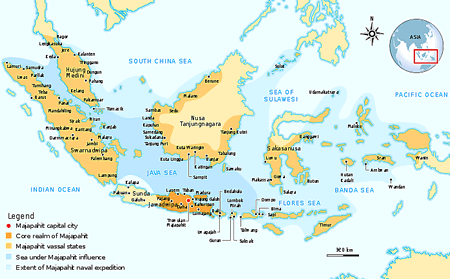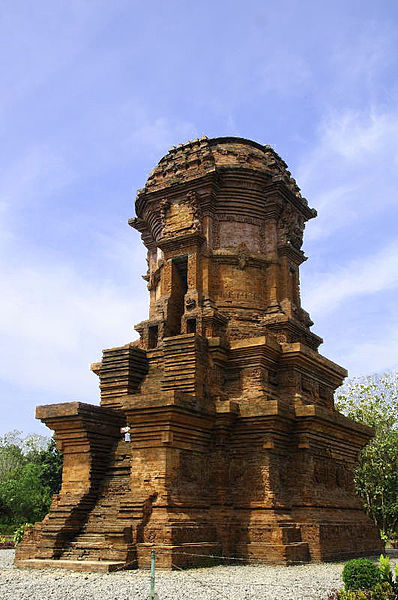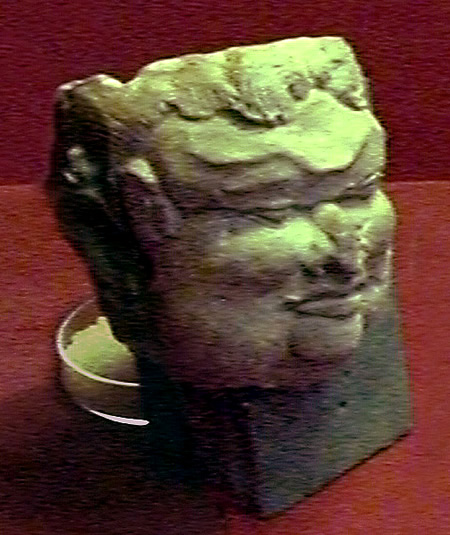World History
After the decline of the Srivijayas, who were based in Palembang, Sumatra, the Singahsari dynasty tried to assert their authority in the Malay Archipelago. Unfortunately for them the powerful Mongol warrior Kubilai Khan interfered with their efforts by trying to subjugate them.
He initially sent peaceful missions to make the Singahsari ruler pay tribute to him. When the last Singahsari ruler, Kertanagara, refused, Kubilai Khan sent a military force to Java to subdue him forcefully. By the time the Mongols reached Java, the Singahsari ruler Kertanagara had been assassinated by the forces of his brother-in-law, Jayakatwang of Kediri, who coveted the throne.
In 1292 Nararya Sanggrama Wijaya, later known as Kertarjasa Jayawardhana, the son-in-law of Kertanegara, went on to establish his own line of dynasty, known as the Majapahit dynasty. He managed to do so through an early alliance with the Mongols, who had come to attack him. After defeating his uncle, Kertajasa managed to expel the Mongols in 1293.
The Hindu-Javanese Majapahit dynasty reigned from about 1293 to 1500 from eastern Java. The name Majapahit is derived from a bitter fruit. Their empire included Borneo, Sumatra, Bali, and the southern part of the Malay Peninsula. It stretched from Irian Jaya in the east to Langkasuka in Malaya in the west.
Either a king or a queen was able to rule. The royal family consisted of the king’s parents, sisters, their husbands, aunts, and uncles, and their respective spouses shared in the administration of the kingdom. They formed the Royal Advisory council, and the Royal Privy councils were consulted by the king before he made any decision.
The Majapahit kingdom achieved great prosperity especially in the 14th century. A key figure in the Majapahit era is Gadjah Mada, who acted as regent and prime minister from 1331 to 1364. Queen Tribuana Tunggadewi, regent for her son Hayam Wuruk, appointed him prime minister.
Gadjah Mada was a skilful politician and was responsible for the glorious period of Majapahit rule. His famous oath, known as Sumpah Palapa, was recorded in the Pararaton or the Book of Kings. He swore to conquer the rest of the Malay Archipelago before indulging in the pleasures of life.
In fact, he named specific locations in his oath, such as Bali, Tumasik (present-day Singapore), Pahang, and Palembang. He succeeded in spreading Majapahit rule in the Malay Archipelago, beyond present-day Indonesia. His conquests even extended to the Muslim city-state of Palembang Sumatra, effectively ending Srivijaya rule. True to his word, he headed a military expedition that conquered Bali in 1343.
In 1350 Queen Tribuana Tunggadewi stepped down and Gadjah Mada served her son, Hayam Wuruk, who ruled until 1389. The young king, who was only 16 years old, gave free rein to his prime minister. Thus Gadjah Mada was free to conquer as many places in the archipelago as he wanted. During this time he succeeded in gaining the islands of the Indonesian Archipelago under Majapahit rule.
During the early 15th century Majapahit rule declined with the rise of the Malacca Sultanate, who were becoming increasingly powerful. Toward the end of their rule, many members of Majapahit aristocracy moved to Bali, where they lived in isolation till the island was colonized.
- Khmer Kingdom
Map of Khmer Kingdom Until 802 the Khmers were organized into a number of warring independent kingdoms. They often fought among themselves and against foreign enemies such as the Chams located in present-day central Vietnam. King Jayavarman I, also named...
- Srivijaya Kingdom
Srivijaya Kingdom The Sailendra dynasty was based in the Kedu plain in Java. They first appeared in the sixth century, around 570. The name Sailendra means “lord of the mountain,†a title derived from the Funanese kings, from whom they claimed...
- History Of Malaysia
History of Malaysia. This is a brief essay on the history of the Asian nation of Malaysia. The Encyclopædia Britannica notes, "Country of Southeast Asia, composed of two noncontiguous regions: Peninsular, or West, Malaysia on the Malay Peninsula and...
- History Of Philippines
History of Philippines. This is a short but good overview to the history of the Philippines. The emphasis is on 20th century political history. Wikipedia notes, "The Republic of the Philippines (Filipino: Republika ng Pilipinas), or the Philippines (Filipino:...
- History Of Brunei Darussalam
History of Brunei Darussalam. This is a good historical overview of the sultanate of Brunei. It is no longer a powerful nation but it has a long history. From the site: Historians believe there was a forerunner to the present Brunei Sultanate, which...
World History
Majapahit Kingdom
 |
| Majapahit Kingdom |
After the decline of the Srivijayas, who were based in Palembang, Sumatra, the Singahsari dynasty tried to assert their authority in the Malay Archipelago. Unfortunately for them the powerful Mongol warrior Kubilai Khan interfered with their efforts by trying to subjugate them.
He initially sent peaceful missions to make the Singahsari ruler pay tribute to him. When the last Singahsari ruler, Kertanagara, refused, Kubilai Khan sent a military force to Java to subdue him forcefully. By the time the Mongols reached Java, the Singahsari ruler Kertanagara had been assassinated by the forces of his brother-in-law, Jayakatwang of Kediri, who coveted the throne.
In 1292 Nararya Sanggrama Wijaya, later known as Kertarjasa Jayawardhana, the son-in-law of Kertanegara, went on to establish his own line of dynasty, known as the Majapahit dynasty. He managed to do so through an early alliance with the Mongols, who had come to attack him. After defeating his uncle, Kertajasa managed to expel the Mongols in 1293.
  |   |
The Hindu-Javanese Majapahit dynasty reigned from about 1293 to 1500 from eastern Java. The name Majapahit is derived from a bitter fruit. Their empire included Borneo, Sumatra, Bali, and the southern part of the Malay Peninsula. It stretched from Irian Jaya in the east to Langkasuka in Malaya in the west.
Either a king or a queen was able to rule. The royal family consisted of the king’s parents, sisters, their husbands, aunts, and uncles, and their respective spouses shared in the administration of the kingdom. They formed the Royal Advisory council, and the Royal Privy councils were consulted by the king before he made any decision.
 |
| temple in Majapahit |
Gadjah Mada was a skilful politician and was responsible for the glorious period of Majapahit rule. His famous oath, known as Sumpah Palapa, was recorded in the Pararaton or the Book of Kings. He swore to conquer the rest of the Malay Archipelago before indulging in the pleasures of life.
In fact, he named specific locations in his oath, such as Bali, Tumasik (present-day Singapore), Pahang, and Palembang. He succeeded in spreading Majapahit rule in the Malay Archipelago, beyond present-day Indonesia. His conquests even extended to the Muslim city-state of Palembang Sumatra, effectively ending Srivijaya rule. True to his word, he headed a military expedition that conquered Bali in 1343.
 |
| Gajah Mada |
In 1350 Queen Tribuana Tunggadewi stepped down and Gadjah Mada served her son, Hayam Wuruk, who ruled until 1389. The young king, who was only 16 years old, gave free rein to his prime minister. Thus Gadjah Mada was free to conquer as many places in the archipelago as he wanted. During this time he succeeded in gaining the islands of the Indonesian Archipelago under Majapahit rule.
During the early 15th century Majapahit rule declined with the rise of the Malacca Sultanate, who were becoming increasingly powerful. Toward the end of their rule, many members of Majapahit aristocracy moved to Bali, where they lived in isolation till the island was colonized.
- Khmer Kingdom
Map of Khmer Kingdom Until 802 the Khmers were organized into a number of warring independent kingdoms. They often fought among themselves and against foreign enemies such as the Chams located in present-day central Vietnam. King Jayavarman I, also named...
- Srivijaya Kingdom
Srivijaya Kingdom The Sailendra dynasty was based in the Kedu plain in Java. They first appeared in the sixth century, around 570. The name Sailendra means “lord of the mountain,†a title derived from the Funanese kings, from whom they claimed...
- History Of Malaysia
History of Malaysia. This is a brief essay on the history of the Asian nation of Malaysia. The Encyclopædia Britannica notes, "Country of Southeast Asia, composed of two noncontiguous regions: Peninsular, or West, Malaysia on the Malay Peninsula and...
- History Of Philippines
History of Philippines. This is a short but good overview to the history of the Philippines. The emphasis is on 20th century political history. Wikipedia notes, "The Republic of the Philippines (Filipino: Republika ng Pilipinas), or the Philippines (Filipino:...
- History Of Brunei Darussalam
History of Brunei Darussalam. This is a good historical overview of the sultanate of Brunei. It is no longer a powerful nation but it has a long history. From the site: Historians believe there was a forerunner to the present Brunei Sultanate, which...
